Charge of the Light Brigade
The Charge of the Light Brigade was a failed military action involving the British light cavalry led by Lord Cardigan against Russian forces during the Battle of Balaclava on 25 October 1854 in the Crimean War. Lord Raglan had intended to send the Light Brigade to prevent the Russians from removing captured guns from overrun Turkish positions, a task for which the light cavalry were well-suited. However, there was miscommunication in the chain of command and the Light Brigade was instead sent on a frontal assault against a different artillery battery, one well-prepared with excellent fields of defensive fire. The Light Brigade reached the battery under withering direct fire and scattered some of the gunners, but they were forced to retreat immediately, and the assault ended with very high British casualties and no decisive gains.
| Charge of the Light Brigade | |||||||
|---|---|---|---|---|---|---|---|
| Part of Battle of Balaclava, Crimean War | |||||||
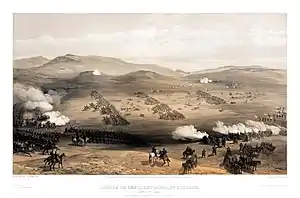 The Charge of the Light Brigade at Balaklava by William Simpson (1855), illustrating the Light Brigade's charge into the "Valley of Death" from the Russian perspective. | |||||||
| |||||||
| Belligerents | |||||||
|
|
| ||||||
| Commanders and leaders | |||||||
|
|
| ||||||
| Strength | |||||||
| About 670 (Adkin: 668; Brighton: "at least" 666) | Unknown | ||||||
| Casualties and losses | |||||||
|
~ 110 killed ~ 161 wounded | Unknown | ||||||
The events were the subject of Alfred, Lord Tennyson's narrative poem "The Charge of the Light Brigade" (1854), published just six weeks after the event. Its lines emphasise the valour of the cavalry in bravely carrying out their orders, regardless of the nearly inevitable outcome. Responsibility for the miscommunication has remained controversial, as the order was vague and Louis Edward Nolan delivered the written orders with some verbal interpretation, then died in the first minute of the assault.
Background

The charge was made by the Light Brigade of the British cavalry, which consisted of the 4th and 13th Light Dragoons, 17th Lancers, and the 8th and 11th Hussars, under the command of Major General James Brudenell, 7th Earl of Cardigan. Also present that day was the Heavy Brigade, commanded by Major General James Yorke Scarlett, who was a past Commanding Officer of the 5th Dragoon Guards. The Heavy Brigade was made up of the 4th Royal Irish Dragoon Guards, the 5th Dragoon Guards, the 6th Inniskilling Dragoons and the Scots Greys. The two brigades were the only British cavalry force at the battle.
The Light Brigade were the British light cavalry force. It mounted light, fast horses which were unarmoured. The men were armed with lances and sabres. Optimized for maximum mobility and speed, they were intended for reconnaissance and skirmishing. They were also ideal for cutting down infantry and artillery units as they attempted to retreat.
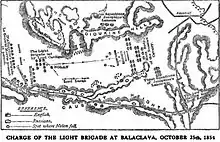
The Heavy Brigade under James Scarlett was the British heavy cavalry force. It mounted large, heavy chargers. The men were equipped with metal helmets and armed with cavalry swords for close combat. They were intended as the primary British shock force, leading frontal charges in order to break enemy lines.
Overall command of the British cavalry resided with Lieutenant General George Bingham, 3rd Earl of Lucan. Cardigan and Lucan were brothers-in-law who disliked each other intensely. Lucan received an order from the army commander Lord Raglan stating: "Lord Raglan wishes the cavalry to advance rapidly to the front, follow the enemy, and try to prevent the enemy carrying away the guns. Troop horse artillery may accompany. French cavalry is on your left. Immediate." Raglan wanted the light cavalry to prevent the Russians from successfully withdrawing the naval guns from the redoubts they had captured on the reverse side of the Causeway Heights, the hill forming the south side of the valley. This was an optimal task for the Light Brigade, as their superior speed would ensure the Russians would be forced to either quickly abandon the cumbersome guns or be cut down en masse while they attempted to flee with them.
Raglan could see what was happening from his high vantage point on the west side of the valley. However, the lie of the land around Lucan and the cavalry prevented him from seeing the Russians' efforts to remove the guns from the redoubts and retreat.[1]
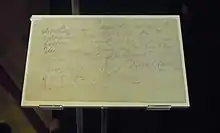
The order was drafted by Brigadier Richard Airey and carried by Captain Louis Edward Nolan. Nolan carried the further oral instruction that the cavalry was to attack immediately.[2] When Lucan asked what guns were referred to, Nolan is said to have indicated with a wide sweep of his arm—not the causeway redoubts—but the mass of Russian guns in a redoubt at the end of the valley, around a mile away.[3] His reasons for the misdirection are unknown because he was killed in the ensuing battle.
In response to the order, Lucan instructed Cardigan to lead his command of about 670 troopers[4] of the Light Brigade straight into the valley between the Fedyukhin Heights and the Causeway Heights. In his poem, "The Charge of the Light Brigade" (1854), Tennyson dubbed this hollow "The Valley of Death".
The opposing Russian forces were commanded by Pavel Liprandi and included approximately 20 battalions of infantry supported by over 50 artillery pieces. These forces were deployed on both sides and at the opposite end of the valley.
Lucan himself was to follow with the Heavy Brigade. Although the Heavy Brigade was better armoured and intended for frontal assaults on infantry positions, neither force was remotely equipped for a frontal assault on a fully dug-in and alerted artillery, much less one with an excellent line of sight over a mile in length and supported on two sides by artillery batteries providing enfilading fire from elevated ground. The semi-suicidal nature of this charge was surely evident to the troopers of the Light Brigade, but if there were any objection to the orders, it was not recorded.
The Charge
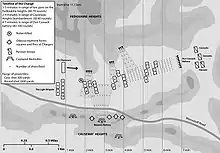
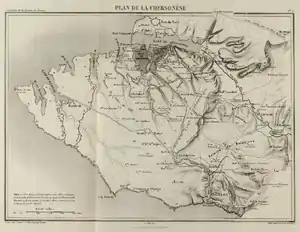
The Light Brigade set off down the valley with Cardigan in front, leading the charge on his horse Ronald.[6][7][8] Almost at once, Nolan rushed across the front, passing in front of Cardigan. It may be that he realised that the charge was aimed at the wrong target and was attempting to stop or turn the brigade, but he was killed by an artillery shell and the cavalry continued on its course. Captain Godfrey Morgan was close by and saw what happened:
The first shell burst in the air about 100 yards in front of us. The next one dropped in front of Nolan's horse and exploded on touching the ground. He uttered a wild yell as his horse turned round, and, with his arms extended, the reins dropped on the animal's neck, he trotted towards us, but in a few yards dropped dead off his horse. I do not imagine that anybody except those in the front line of the 17th Lancers saw what had happened.
We went on. When we got about two or three hundred yards the battery of the Russian Horse Artillery opened fire. I do not recollect hearing a word from anybody as we gradually broke from a trot to a canter, though the noise of the striking of men and horses by grape and round shot was deafening, while the dust and gravel struck up by the round shot that fell short was almost blinding, and irritated my horse so that I could scarcely hold him at all. But as we came nearer I could see plainly enough, especially when I was about a hundred yards from the guns. I appeared to be riding straight on to the muzzle of one of the guns, and I distinctly saw the gunner apply his fuse. I shut my eyes then, for I thought that settled the question as far as I was concerned. But the shot just missed me and struck the man on my right full in the chest.
In another minute I was on the gun and the leading Russian's grey horse, shot, I suppose, with a pistol by somebody on my right, fell across my horse, dragging it over with him and pinning me in between the gun and himself. A Russian gunner on foot at once covered me with his carbine. He was just within reach of my sword, and I struck him across his neck. The blow did not do much harm, but it disconcerted his aim. At the same time a mounted gunner struck my horse on the forehead with his sabre. Spurring "Sir Briggs," he half jumped, half blundered, over the fallen horses, and then for a short time bolted with me. I only remember finding myself alone among the Russians trying to get out as best I could. This, by some chance, I did, in spite of the attempts of the Russians to cut me down.[9]
The Light Brigade faced withering fire from three sides which devastated their force on the ride, yet they were able to engage the Russian forces at the end of the valley and force them back from the redoubt. Nonetheless, they suffered heavy casualties and were soon forced to retire. The surviving Russian artillerymen returned to their guns and opened fire with grapeshot and canister shot, indiscriminately at the mêlée of friend and foe before them.[2] Captain Morgan continues:
When clear again of the guns I saw two or three of my men making their way back, and as the fire from both flanks was still heavy it was a matter of running the gauntlet again. I have not sufficient recollection of minor incidents to describe them, as probably no two men who were in that charge would describe it in the same way. When I was back pretty nearly where we started from I found that I was the senior officer of those not wounded, and, consequently, in command, there being two others, both juniors to me, in the same position — Lieut. Wombwell and Cornet Cleveland.[9]
Lucan and his troops of the Heavy Brigade failed to provide any support for the Light Brigade—they entered the mouth of the valley but did not advance further. Lucan's explanation was that he saw no point in having a second brigade mown down, and he was best positioned to render assistance to Light Brigade survivors returning from the charge. The French light cavalry, the Chasseurs d'Afrique, was more effective by clearing the Fedyukhin Heights of the two half-batteries of guns, two infantry battalions, and Cossacks to ensure that the Light Brigade would not be hit by fire from that flank, and it provided cover for the remaining elements of the Light Brigade as they withdrew.[2][10]

War correspondent William Howard Russell witnessed the battle and declared: "Our Light Brigade was annihilated by their own rashness, and by the brutality of a ferocious enemy."[2]
Cardigan survived the battle, although stories circulated that he was not actually present.[11] He led the charge from the front, never looking back, and did not see what was happening to the troops behind him. He reached the Russian guns, took part in the fight, and then returned alone up the valley without bothering to rally or even find out what had happened to the survivors. He afterwards said that all he could think about was his rage against Captain Nolan, who he thought had tried to take over the leadership of the charge. After riding back up the valley, he considered that he had done all that he could. He left the field and boarded his yacht in Balaklava harbour, where he ate a champagne dinner.[12] He described the engagement in a speech delivered at Mansion House, London which was quoted in the House of Commons:
We advanced down a gradual descent of more than three-quarters of a mile [1.2 km], with the batteries vomiting forth upon us shells and shot, round and grape, with one battery on our right flank and another on the left, and all the intermediate ground covered with the Russian riflemen; so that when we came to within a distance of fifty yards from the mouths of the artillery which had been hurling destruction upon us, we were, in fact, surrounded and encircled by a blaze of fire, in addition to the fire of the riflemen upon our flanks.
As we ascended the hill, the oblique fire of the artillery poured upon our rear, so that we had thus a strong fire upon our front, our flank, and our rear. We entered the battery—we went through the battery—the two leading regiments cutting down a great number of the Russian gunners in their onset. In the two regiments which I had the honour to lead, every officer, with one exception, was either killed or wounded, or had his horse shot under him or injured. Those regiments proceeded, followed by the second line, consisting of two more regiments of cavalry, which continued to perform the duty of cutting down the Russian gunners.
Then came the third line, formed of another regiment, which endeavoured to complete the duty assigned to our brigade. I believe that this was achieved with great success, and the result was that this body, composed of only about 670 men, succeeded in passing through the mass of Russian cavalry of—as we have since learned—5,240 strong; and having broken through that mass, they went, according to our technical military expression, "threes about," and retired in the same manner, doing as much execution in their course as they possibly could upon the enemy's cavalry. Upon our returning up the hill which we had descended in the attack, we had to run the same gauntlet and to incur the same risk from the flank fire of the Tirailleur as we had encountered before. Numbers of our men were shot down—men and horses were killed, and many of the soldiers who had lost their horses were also shot down while endeavouring to escape.
But what, my Lord, was the feeling and what the bearing of those brave men who returned to the position. Of each of these regiments there returned but a small detachment, two-thirds of the men engaged having been destroyed? I think that every man who was engaged in that disastrous affair at Balaklava, and who was fortunate enough to come out of it alive, must feel that it was only by a merciful decree of Almighty Providence that he escaped from the greatest apparent certainty of death which could possibly be conceived.
New information found in 2016
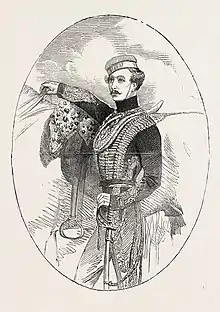
A newspaper report on 11 December 2016[13][14] revealed another version of what happened when a letter was found in the British Library, written by Lieutenant Frederick Maxse who was on Lord Raglan's staff at Balaclava. It said that Lord Raglan had sent an order for the Light Brigade to "follow the enemy and try to prevent the enemy from carrying away the guns", referring to some British artillery which were at risk. Raglan sent the order with Captain Louis Nolan, who passed it on to Lucan orally instead of handing over the written orders. He said, "There, my lord, is your enemy! There are your guns!", adding the word "attack", whereas Raglan had intended merely a show of force. Nolan's version of the order and accompanying gesture were misunderstood, causing the disaster described above. Nolan rode with the charge and was one of the first to fall in it. Maxse's letter said that Nolan was annoyed at how little the Light Brigade had done previously in the campaign, and that he was bitter against Lucan. Nigel Kingscoteé, another of Raglan's staff officers, agreed that the fault was Nolan's and said that Nolan would have been "broke by court martial" if he had survived.
David Kelsey of the Crimean War Research Society believes that the new evidence does not warrant rewriting the history of the Charge, stating that Lord Raglan had "...ordered a cavalry movement which could serve no long-term purpose."[15]
Aftermath


The brigade was not completely destroyed, but did suffer terribly, with 118 men killed, 127 wounded, and about 60 taken prisoner. After regrouping, only 195 men were still with horses. The futility of the action and its reckless bravery prompted the French Marshal Pierre Bosquet to state: "C'est magnifique, mais ce n'est pas la guerre." ("It is magnificent, but it is not war.") He continued, in a rarely quoted phrase: "C'est de la folie" — "It is madness."[16] The Russian commanders are said to have initially believed that the British soldiers must have been drunk.[12] Somerset Calthorpe, aide-de-camp to Lord Raglan, wrote a letter to a friend three days after the charge. He detailed casualty numbers but did not distinguish between those killed and those taken prisoner:
"Killed and missing. Wounded. 9 Officers 12 14 Sergeants 9 4 Trumpeters 3 129 Rank and file 98 156 Total 122 278 casualties; — besides 335 horses killed in action, or obliged afterwards to be destroyed from wounds. It has since been ascertained that the Russians made a good many prisoners; the exact number is not yet known."[17]
The reputation of the British cavalry was significantly enhanced as a result of the charge, though the same cannot be said for their commanders.
Slow communications meant that news of the disaster did not reach the British public until three weeks after the action. The British commanders' dispatches from the front were published in an extraordinary edition of the London Gazette of 12 November 1854. Raglan blamed Lucan for the charge, claiming that "from some misconception of the order to advance, the Lieutenant-General (Lucan) considered that he was bound to attack at all hazards, and he accordingly ordered Major-General the Earl of Cardigan to move forward with the Light Brigade."[18] Lucan was furious at being made a scapegoat: Raglan claimed he should have exercised his discretion, but throughout the campaign up to that date Lucan considered Raglan had allowed him no independence at all and required that his orders be followed to the letter. Cardigan, who had merely obeyed orders, blamed Lucan for giving those orders. Cardigan returned home a hero and was promoted to Inspector General of the Cavalry.
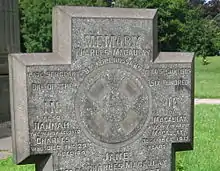
Lucan attempted to publish a letter refuting point by point Raglan's London Gazette dispatch, but his criticism of his superior was not tolerated, and Lucan was recalled to England in March 1855. The Charge of the Light Brigade became a subject of considerable controversy and public dispute on his return. He strongly rejected Raglan's version of events, calling it "an imputation reflecting seriously on my professional character." In an exchange of public correspondence printed in the pages of The Times, Lucan blamed Raglan and his deceased aide-de-camp Captain Nolan, who had been the actual deliverer of the disputed order. Lucan subsequently defended himself with a speech in the House of Lords on 19 March.
Lucan evidently escaped blame for the charge, as he was made a member of the Order of the Bath in July of that same year. Although he never again saw active duty, he reached the rank of general in 1865 and was made a field marshal in the year before his death.
The charge continues to be studied by modern military historians and students as an example of what can go wrong when accurate military intelligence is lacking and orders are unclear. Prime Minister Winston Churchill, who was a keen military historian and a former cavalryman, insisted on taking time out during the Yalta Conference in 1945 to see the battlefield for himself.
One research project used a mathematical model to examine how the charge might have turned out if conducted differently. The analysis suggested that a charge toward the redoubt on the Causeway Heights, as Raglan had apparently intended, would have led to even higher British casualties. By contrast, the charge might have succeeded if the Heavy Brigade had accompanied the Light Brigade along the valley, as Lucan had initially directed.[19]
According to Norman Dixon, 19th-century accounts of the charge tended to focus on the bravery and glory of the cavalrymen, much more than the military blunders involved, with the perverse effect that it "did much to strengthen those very forms of tradition which put such an incapacitating stranglehold on military endeavor for the next eighty or so years," i.e., until after World War I.[20]
The fate of the surviving members of the charge was investigated by Edward James Boys, a military historian, who documented their lives from leaving the army to their deaths. His records are described as being the most definitive project of its kind ever undertaken.[21] Edwin Hughes, who died on 14 May 1927, aged 96, was the last survivor.[22]
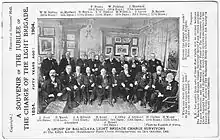
In October 1875, survivors of the charge met at the Alexandra Palace in London to celebrate its 21st anniversary. The celebrations were fully reported in the Illustrated London News of 30 October 1875,[23] which included the recollections of several of the survivors, including those of Edward Richard Woodham, the Chairman of the Committee that organised the celebration. Tennyson was invited, but could not attend. Lucan, the senior commander surviving, was not present, but attended a separate celebration, held later in the day, with other senior officers at the fashionable Willis's Rooms, St James's Square.[24] Reunion dinners were held for a number of years.[25]
On 2 August 1890, trumpeter Martin Leonard Landfried, from the 17th Lancers, who may (or may not)[26] have sounded the bugle charge at Balaclava, made a recording on an Edison cylinder that can be heard here, with a bugle which had been used at Waterloo in 1815.[27]
In 2004, on the 150th anniversary of the charge, a commemoration of the event was held at Balaklava. As part of the anniversary, a monument dedicated to the 25,000 British participants of the conflict was unveiled by Prince Michael of Kent.[28]
Survivor postscript
A survivor, John Penn, who died in Dunbar in 1886, left a personal account of his military career, including the Charge, written for a friend. This survives and is held by East Lothian Council Archives.[29]
Private William Ellis of the 11th Hussars was erroneously described as the last survivor of the Charge at the time of his funeral at Upper Hale Cemetery in Farnham, Surrey in 1913 after his death aged 82.[30][31][32] A number of individuals who died during 1916–17 were thought to be the 'last' survivor of the Charge of the Light Brigade. These include Sergeant James A. Mustard of the 17th Lancers, aged 85, who had his funeral with military honours at Twickenham in early February 1916. In the Abergavenny Chronicle news report published on 11 February it was stated:
He was one of thirty-eight men of the 145 of the 17th Lancers that came out of the charge led by Cardigan, and was always of the opinion that no one sounded the charge at all. He was in the battles of Alma and Mackenzie's Farm, and the storming and taking of Sebastopol, and before leaving for Varna marched with his regiment from Hampton Court to Portsmouth.[33]
In The Cambrian News of 30 June 1916, the passing of another 'last' was noted, Thomas Warr, aged 85, at Dorchester:
At the meeting of the Royal Patriotic Fund Corporation in London last week Mr. Hayes Fisher, M.P., who presided, said that the last pensioned survivor of the Charge of the Light Brigade died on the previous day. His name was Thomas Warr.[34]
Charger William Henry Pennington of the 11th Hussars, who carved a relatively successful career as a Shakespearean actor on leaving the Army, died in 1923.[32][35] The last survivor was Edwin Hughes of the 13th Light Dragoons, who died on 18 May 1927, aged 96.[36]
Remembrance
| Wikisource has original text related to this article: |
Poet Laureate Alfred, Lord Tennyson wrote evocatively about the battle in his poem "The Charge of the Light Brigade". Tennyson's poem, written 2 December and published on 9 December 1854, in The Examiner, praises the brigade ("When can their glory fade? O the wild charge they made!") while trenchantly mourning the appalling futility of the charge ("Not tho' the soldier knew, someone had blunder'd... Charging an army, while all the world wonder'd"). Tennyson wrote the poem inside only a few minutes after reading an account of the battle in The Times, according to his grandson Sir Charles Tennyson. It immediately became hugely popular, and even reached the troops in the Crimea, where it was distributed in pamphlet form.
Nearly 36 years later, Kipling wrote "The Last of the Light Brigade" (1890), commemorating a visit by the last 20 survivors to Tennyson (then aged 80) to reproach him gently for not writing a sequel about the way in which England was treating its old soldiers.[37] Some sources treat the poem as an account of a real event,[38] but other commentators class the destitute old soldiers as allegorical, with the visit invented by Kipling to draw attention to the poverty in which the real survivors were living, in the same way that he evoked Tommy Atkins in "The Absent-Minded Beggar" (1899).[39][40]
References
- Woodham Smith, Cecil (1953). The Reason Why. Constable. p. 235.
- Correspondent (14 November 1854). "The Cavalry Action at Balaclava 25 October". The Times (21898). pp. 7–8. Although unnamed, the correspondent was William Howard Russell
- Woodham Smith, p. 239.
- Russell's report in The Times recorded that just short of 200 men were sick or for other reasons left behind in camp on the day, leaving "607 sabres" to take part in the charge.
- Dutton, Roy (2007). Forgotten Heroes: The Charge of the Light Brigade. InfoDial Ltd. ISBN 978-0-9556554-0-1.
- "Lieutenant-Colonel (later Lieutenant-General) James Thomas Brudenell, 7th Earl of Cardigan, 11th (Prince Albert's Own) Hussars, 1854", Online Collection National Army Museum, London
- Undated issue of Saddle & Bridle ISSN 0036-2271, St Louis, MO, quoted in Ronald, Heroic War Horse of the Charge of the Light Brigade, Muncie, IN: Horse Show Central, archived from the original on 6 October 2009, retrieved 3 March 2009
- "Earl Cardigan's Cavalry Horses", The Era, London: Frederick Ledger (852), 21 January 1855
- Morgan, Godfrey Charles (4 November 1897). "The Charge of the Light Brigade. Lord Tredegar Interviewed". Flintshire Observer, Mining Journal and General Advertiser, for the Counties of Flint and Denbigh, 43(1,827). p. 6, c. 2. Retrieved 14 November 2016.
- "Battles: Charge of the Light Brigade". History of war.
- Woodham Smith, p. 258.
- Woodham Smith, p. 262.
- Sunday Telegraph Sunday 11 December 2016, p. 12
- "Letter sheds light on who was to blame for 'blunder' which sent Light Brigade into the Valley of Death". The Telegraph. 10 December 2016. Retrieved 29 December 2016.
- "The Maxse Letter". Crimean War Research Society.
- Raugh, Harold E. (2004). The Victorians at War, 1815–1914: An Encyclopedia of British Military History. Santa Barbara, CA: ABC CLIO. p. 93. ISBN 1-57607-926-0.
- Calthorpe, Somerset John Gough (1857). Letters from Headquarters: Or, The Realities of the War in the Crimea, by an Officer on the Staff. London: John Murray. p. 132.
- "No. 21624". The London Gazette. 12 November 1854. p. 3456.
- Connors D.; Armstrong, M.J. & Bonnett, J. (2015). "A counterfactual study of the Charge of the Light Brigade". Historical Methods. 48 (2): 80–89. doi:10.1080/01615440.2014.979273. S2CID 56078521.
- Dixon, Norman (1976). On the Psychology of Military Incompetence. London: Jonathan Cape. p. 41. ISBN 0-224-01161-8.
- "The E.J. Boys Archive online". ChargeOfTheLightBrigade.com.
- "Edwin Hughes". BBC. 27 July 2009. Retrieved 24 August 2009.
- "Calaclava" (PDF). Julienco.com.
- "The Officers' Dinner". Illustrated London News. 67 (1890): 6. 30 October 1875.
- Dutton lists them, and the attendees where known
- Greenwood, Hilary (October 2012). "Martin Leonard Landfried". Shoreham Fort. Friends of Shoreham Fort. Retrieved 3 May 2016.
Later Landfried became famous as the man who sounded the charge of the Light Brigade but it is not clear whether this was his responsibility or not. Taking part in the charge were 17 men listed as trumpeters on the muster rolls... including William Brittain who rode with Lord Cardigan in the Charge. [...] There is much argument about whether the 'charge' was actually sounded at all [...] William Brittain, it is agreed, sounded the 'walk, trot, gallop' and he may have sounded the 'charge.' It may be that one or more of the other trumpeters sounded the charge.
- Hilary Greenwood (22 June 2004). "Trumpeter Landfrey's Charge of the Light Brigade". Internet Archive. Internet Archive. Retrieved 3 May 2016.
Martin Landfried retired as bandmaster for the 1st Sussex Artillery Volunteers at Shoreham Fort, West Sussex, UK. He left the army in 1865 [...] At the time of his death he was living in Portland Road Hove and his grave is Hove Cemetery. The recording was made and distributed by the Light Brigade Relief Fund. The aim was to benefit the remaining veterans and inform the public about the bad times some of them had fallen on. [...] Researched by Hilary Greenwood, Shoreham Fort historian
. Landfried's name is misspelled as "Landfrey" at the beginning of the annotations to the recording; and the annotations refer to the instrument as a trumpet, but Landfried twice calls it a bugle. - "Remembering Together: Sevastopol in the Crimean War". The quarterly magazine of the British Embassy in Kyiv. Archived from the original on 8 January 2008.
- Penn, John. "You searched for". John Gray Centre. Retrieved 29 December 2016.
- 'Death of William Ellis, last of the Six Hundred', Aberdeen Press and Journal, Aberdeenshire, Scotland, 10 June 1913, Page 4
- Lawrence W. Crider (2004). In Search of the Light Brigade. Lawrence Crider. p. 169. ISBN 978-1-898763-12-3.
- Glenn Christodoulou, 'Forgotten Men of the Light Brigade' - The War Correspondent: Journal of the Crimean War Research Society (October 1986)
- Anon. (11 February 1916). "Last Balaclava Hero". Abergavenny Chronicle, Monmouthshire Advertiser, Brynmawr, Blaenavon, Tredegar, Abersychan, Crickhowell, Pontypool, Usk, Raglan, Monmouth, Longtown, Pontrilas, Grosmont and Skenfrith Record, 80. p. 2, c. 3. Retrieved 14 November 2016.
- Anon. (30 June 1916). "Brevities". The Cambrian News, Merionethshire Standard and Welsh Farmers' Gazette, (2,891). p. 3, c. 5. Retrieved 14 November 2016.
- Roy Dutton (2007). Forgotten Heroes: The Charge of the Light Brigade. Infodial Ltd. p. 158. ISBN 978-0-9556554-0-1.
- Mark Adkin (30 April 2017). The Charge: The Real Reason Why the Light Brigade Was Lost. Pen and Sword. p. 259. ISBN 978-1-5267-0722-2.
- Kipling, Rudyard (28 April 1890). "The Last of the Light Brigade". St James's Gazette. London.
- Staff writer (2 November 1913). "Last "Light Brigade" officer dies; Kipling poem discovered". The New York Times. p. SM8. Retrieved 7 April 2009.
- Brighton, Terry (2004). Hell riders: the true story of the charge of the Light Brigade. New York: Henry Holt. pp. 229–34. ISBN 0-8050-7722-7.
- Lootens, Tricia (2000). "Victorian poetry and patriotism". In Bristow, Joseph (ed.). The Cambridge companion to Victorian poetry. Cambridge, England: Cambridge University Press. pp. 269–70. ISBN 0-521-64115-2.
Further reading
- The Reason Why, Story of the Fatal Charge of the Light Brigade, Cecil Woodham-Smith, Penguin Books, ISBN 0-14-139031-X, first published in 1953 by Constable for the Book Society.
- Hell Riders: The True Story of the Charge of the Light Brigade, Terry Brighton, Henry Holt and Co, ISBN 0-8050-7722-7, published 2 November 2004.
- Forgotten Heroes: The Charge of the Light Brigade, Roy Dutton, InfoDial Ltd., ISBN 0-9556554-0-4, published 25 October 2007.
- The Charge of the Light Brigade Contemporary eyewitness account from journalist William Howard Russell .
- Illustrated London News 30 October 1875, reporting the celebration at Alexandra Palace of the survivors of the Charge and some of their recollections including those of Edward Richard Woodham the Chairman of the Committee that organised the celebration
- The Charge. The Real Reason Why the Light Brigade was Lost, Mark Adkin, Leo Cooper, London 1996, ISBN 0-85052-469-5, (also: Pimlico, London 2004, ISBN 1-84413-734-1).
- "New Accounts Emerge of Charge of the Light Brigade", Jasper Copping, The Telegraph, London, 20 Apr. 2014.
- "Flashman at the Charge," (fiction), George McDonald Fraser, c. 1980.
External links
- Confirmed Chargers:, Forgotten Heroes Charge of the Light Brigade
| Wikisource has original text related to this article: |
| Wikimedia Commons has media related to Charge of the Light Brigade. |
- Charge of the Light Brigade on In Our Time at the BBC
- Nationalarchives.gov.uk, The National Archives: Charge of the Light Brigade
- Eserver.org, The Charge of the Light Brigade by Lord Alfred Tennyson
- Virginia.eud, A copy of the poem hand-written by Tennyson
- BBC.co.uk, illustrated history of the Charge of the Light Brigade
- Loc.gov, Roger Fenton photographs
- Kipling.org.uk, The Last of the Light Brigade by Rudyard Kipling
- Plus.com, Casualty list
- NPR.org, Retelling the Tale of the Light Brigade
- The monument to the charge in Ukraine at Find a Grave
- www.archive.org Trumpeter Martin Landfrey (or Lanfried) plays the charge he sounded at the Charge of the Light Brigade. He uses a bugle which was previously used by Wellington's forces at the Battle of Waterloo in 1815. Edison cylinder recording, 2 August 1890, London.
- Julienco.com, Illustrated London News Article dated 30 October 1875 about the 21st Anniversary Reunion dinner at Alexandra Palace on 25 October 1875.